Because of time constraints (working on copy edits for new book) and weather, the brief walk on the land Saturday didn’t produce any usable bird pictures and I didn’t see any snakes or lizards, but I did see wildlife, large and small:
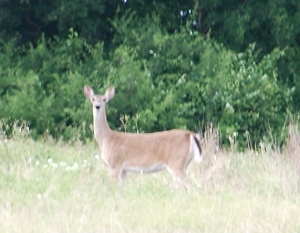 Two deer spooked from the angle of the dry woods and north fenceline when I came around the southwest end of the dry woods; this one stopped for a moment after the first two leaps. The other was already halfway to the creek, and this one took off as well. I discovered later that they’d eaten the flower stalks off the one Hesperaloe that flowered this year. Would be more annoyed, but we plant native plants for the wildlife, not just for us.
Two deer spooked from the angle of the dry woods and north fenceline when I came around the southwest end of the dry woods; this one stopped for a moment after the first two leaps. The other was already halfway to the creek, and this one took off as well. I discovered later that they’d eaten the flower stalks off the one Hesperaloe that flowered this year. Would be more annoyed, but we plant native plants for the wildlife, not just for us.
Before I got that far, I’d already found two other wildlife species, one new to me:
Tetraopes texanus on Green Antelope Horns milkweed, Asclepias viridis; this little milkweed beetle looks a lot like T. femoratus, but has those feathery setae (like feathers or hairs) coming out of the joints of its antennae and the tips are flattened and pointed.
On the same milkweed plant, I found this snail snuggled into the fold of a leaf:
Up in the dry woods, where the prickly pear are coming into bloom, all lemon yellow at this point, I spotted something tiny and green in a cactus flower. I photograph anything in a cactus flower I haven’t seen before, because these flowers attract many insects after the abundant pollen.
From a distance, I’d thought it might be an early Green Lynx spider, but closer I could tell it was an insect, not an arachnid. But what?
It’s a katydid nymph (thanks once more, BugGuide.net! This picture nailed the ID for me.)
Another dry woods find: a female crane-fly on greenbrier.
I believe this is the same as the smaller one I photographed before.
And finally, for the sheer beauty, a fresh Black Swallowtail nectaring on what I think is Prairie Brazoria–a mint-family plant, anyway, that grows in abundance along the margins of the west dry woods if there’s been enough rain.
Although in the past people might think the whitetail deer as the only real wildlife in these pictures, they’re all wildlife, and they all sustain the ecosystem that supports the deer (top-level herbivores.) Our project is aimed at supporting wildlife in the broad sense–native “critters” of every size and shape. The wigglies and the creepy-crawlies included.
Prairie restoration and restoration of native plant species in the creek woods and dry woods rebuild the vegetation that supports the wildlife, and the wildlife eat and are eaten in a complex web that strengthens as it multiplies. A rough count of the species added since the last totting up shows that we’re close to, or above, 500 species of critters seen on the place now. And I know there are invertebrates we haven’t found yet…and more will likely move in as long as we keep improving habitat.

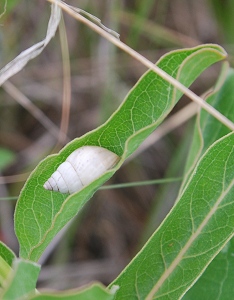
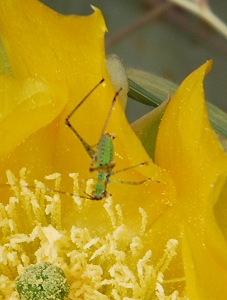
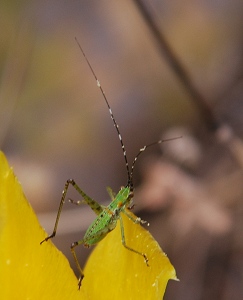
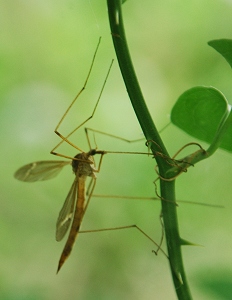
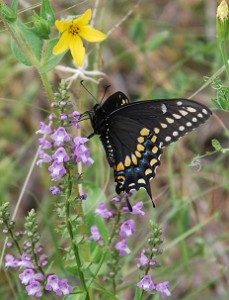
Comment by Mary Anne in Kentucky — May 10, 2010 @ 4:52 pm
That beetle is so beautiful. (And I’m grateful I have a more level bed than the snail.)
Comment by elizabeth — May 10, 2010 @ 10:14 pm
Glad you liked the beetle–so did I. I think it’s charming. I wonder–if we lived in spiral shells like snails, would we even notice a sloping bed?
Comment by Abigail Miller — May 14, 2010 @ 8:40 pm
My attempts (and so far they are all attempts, not faits accomplis) to get sharp photos of my bees, even when I know precisely where they have to come to go in the hive entrance, has given me a heightened respect for your gorgeous pictures of your small wildlife.
I am sure 90% of it is skill and practice. but you did mention that your camera is well suited to wildlife photography. Do you mind telling us what it is? Maybe it’s time I spent some money in that direction; I’ve had my little Olympus 740 for eight years now, which pretty well dates it back to the dawn of time as electronic cameras go. 3.2 whole megapixels! It’s given me much enjoyment, but there is a quite distinct lag between pressing the button and getting the image, which is severely frustrating with fast-disappearing critters. I do better with nice sessile plants.
Comment by elizabeth — May 14, 2010 @ 10:37 pm
That lag between pressing the button and capturing the image drove me nuts with our first two simple digital cameras (2001 and 2003 when the 2001 one croaked.) I had done a fair bit with 35mm in the past, with Nikon camera and several lenses.
My first digital SLR, therefore, was a Nikon D70, about 2005, I think, so I could use my older lenses. (Or so I thought…) On the advice of the guys at Precision Camera, to whom I explained what I wanted to shoot and that I’d done field photography before, I bought a Tamron 70-300mm macro zoom. That’s an incredibly useful lens for walking around and shooting just about whatever you want. You can’t get as close as with a macro (which I had, and can use) and the glass isn’t quite as good as Nikkor lenses, but the ability to shoot with the zoom cranked all the way out, 18 inches from a bug…or grab a shot of a bird in the air for later ID…really gave me a thrill.
However, the D70 didn’t give me enough pixels for some of what I wanted to do, even on the fine setting, and in 2007 or 2008 (don’t recall) I moved up to a D80. I also lucked into a used 300mm Nikkor telephoto which I use paired with a Tamron 1.4 teleconverter to make what I call “Bird One”–my main bird lens when I’m set up near one of the water sources. It’s a heavy thing to hand-hold (I have a good monopod) but my best bird pictures were taken with it, as well as some of the dragonflies. Bird One is only really useful in a static setting, and there’s no zoom.
However, I know people getting shots as good as, or better than, mine with Canon as well as Nikon, and in the less-than-SLR versions of both–they now have considerable zoom built in.
Comment by Martin LaBar — May 20, 2010 @ 6:51 am
Yes, that’s a beautiful beetle!